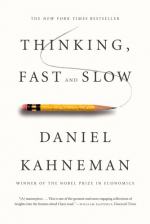
|
| Name: _________________________ | Period: ___________________ |
This quiz consists of 5 multiple choice and 5 short answer questions through Chapters 19 - 24.
Multiple Choice Questions
1. Who created the Remote Association Test to study creativity?
(a) Samoff Mednick.
(b) Danny Oppenheimer.
(c) Daniel Gilbert.
(d) Shane Frederick.
2. In the example where the author presents two candidates for a college professorship, which individual is described as recently completing her graduate work?
(a) Kim.
(b) Anne.
(c) Mary.
(d) Sarah.
3. What illusion is posed by the author in Chapter 6 when he asks about how many animals were brought upon the ark?
(a) The Moses Illusion.
(b) The Biblical Illusion.
(c) The Muller-Lyer illusion.The
(d) The Noah Illusion.
4. In what branch of the military did the author complete service?
(a) U.S. Marines.
(b) Israeli Army.
(c) British Navy.
(d) French Navy.
5. The operations of System 2 have one feature in common. What is this feature?
(a) They are fast.
(b) They are heuristic.
(c) They require attention.
(d) They are automatic.
Short Answer Questions
1. Who is the author's Princeton colleage that wrote "Consequences of Erudite Vernacular Utilized Irrespective of Necessity: Problems with Using Long Words Needlessly"?
2. In the aphorisms presented by the author in Chapter 5, what aphorisms were judged to be more insightful to study participants?
3. Who introduced the labels System 1 and System 2 as systems of the mind?
4. What comparison does the author make between six-year-old boys and six-year-old girls in Chapter 10?
5. What is System 2 in charge of in terms of behavior?
|
This section contains 258 words (approx. 1 page at 300 words per page) |

|




